Maya pyramids
THIS PAGE IS UNDER CONSTRUCTION
--------------------------------------------------------------------------------
Mayan pyramid of Inscriptions at Palenque
--------------------------------------------------------------------------------
--------------------------------------------------------------------------------
In Tula, Mexico: Elevation; 6,500 feet.
This sites presents a five-terraced Tlahuizcalpantecuhtli Pyramid.
Tula is an ancient Toltec city.
--------------------------------------------------------------------------------
Cholula, Mexico
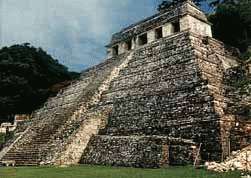
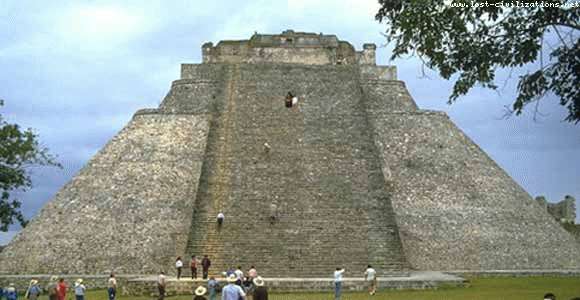
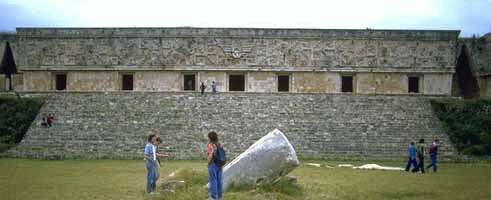
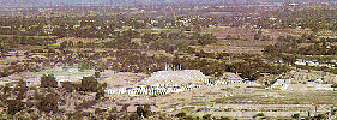
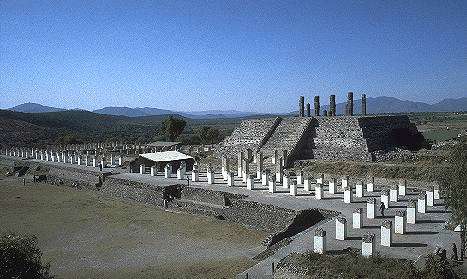
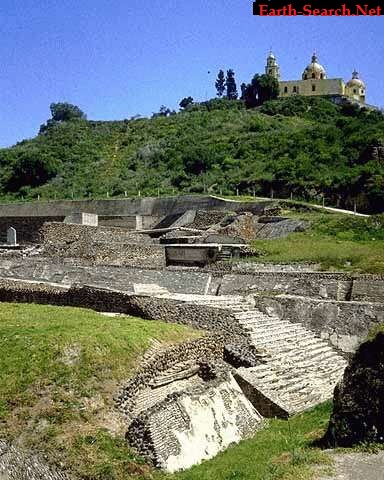
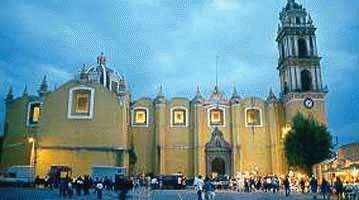
The term "pyramid" is a geometric reference to the shape of these construction. The Mayan version of the pyramid is truncated so that a temple can be built on the top(Stierlin99).
The ancient Mayans built two types of pyramids, those that were meant to be climbed and those that were not. The first type was used for holding sacrificial rituals. The other type was not meant to be touched and was sacred. The steps on theses structures were too steep to climb and many times they had doorways leading to nowhere. During their rituals, the priests would ascend the pyramid from the earth to the sky by means of staircases. They believed that this brought them closer to the gods(Stierlin 98).
These staircases lead from ground level to the temple. The number of staircases that the pyramids had varied, but there were typically two or four. Many times there would be a platform connecting the steps somewhere near the middle of the pyramid so that the priest-king could stop and do a part of his ritual before continuing to the top(Stierlin 98).
Aside from having religious functions, Mayan pyramids also had other purposes. The pyramids were built so high that their tops could be seen protruding out of the jungle. Because of this, the Mayan people were able to use them as landmarks. That was not the only significance of building them so high though. They also served as a reminder that the gods were ever present(Hernandez 13).
Some pyramids even house burial chambers for high ranking officials. Housed inside these mammoth structures were small burial rooms. There were narrow corridors that led to these chambers(Hernandez 21). These burial chambers often contained treasures such as jade(Hernandez 13).
Aztec pyramids were comparatively similar to ones of the Maya. One exceptionis that the Aztecs often built two or more temples at the top while the Mayan pyramids generally had one.
The ancient Mayans built two types of pyramids, those that were meant to be climbed and those that were not. The first type was used for holding sacrificial rituals. The other type was not meant to be touched and was sacred. The steps on theses structures were too steep to climb and many times they had doorways leading to nowhere. During their rituals, the priests would ascend the pyramid from the earth to the sky by means of staircases. They believed that this brought them closer to the gods(Stierlin 98).
These staircases lead from ground level to the temple. The number of staircases that the pyramids had varied, but there were typically two or four. Many times there would be a platform connecting the steps somewhere near the middle of the pyramid so that the priest-king could stop and do a part of his ritual before continuing to the top(Stierlin 98).
Aside from having religious functions, Mayan pyramids also had other purposes. The pyramids were built so high that their tops could be seen protruding out of the jungle. Because of this, the Mayan people were able to use them as landmarks. That was not the only significance of building them so high though. They also served as a reminder that the gods were ever present(Hernandez 13).
Some pyramids even house burial chambers for high ranking officials. Housed inside these mammoth structures were small burial rooms. There were narrow corridors that led to these chambers(Hernandez 21). These burial chambers often contained treasures such as jade(Hernandez 13).
Aztec pyramids were comparatively similar to ones of the Maya. One exceptionis that the Aztecs often built two or more temples at the top while the Mayan pyramids generally had one.
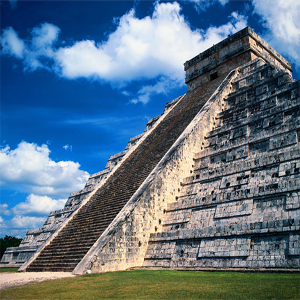


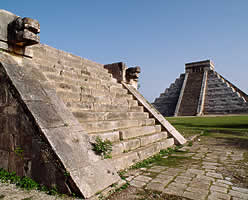

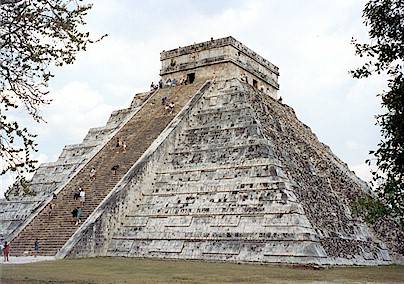

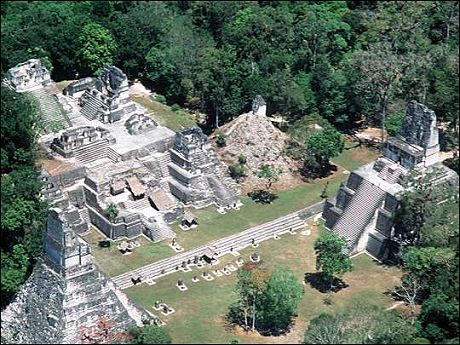

The complicated design of the Mayan pyramids of Teotihuacan features avenues, plazas and 600 pyramids amid a sacred landscaped complex man-made mountains and foothills. The greatest pyramid in the complex is the Pyramid of the Sun, which was built on top of a natural cave containing four chambers. The cave was discovered in 1971 and contained remains of ritual offerings.
Materials
Some pyramids feature an inner layer of mica imported from Brazil 2,000 miles away without the benefit of wheeled transportation. It’s believed the mica acted as insulation. Other Mayan pyramids were covered with stucco that left unattended would turn to mud. Once the pyramids were abandoned, the pyramids revered to mud with plants and trees sprouting from the mounds.
Many pyramids featured elaborate decorative murals, including the Teotihuacan Spider Woman, a goddess believed by the Mayans to have created the universe. The Spider Woman is a deity closely related to the Spider Grandmother, who is prominent in Navajo and Pueblo mythology.
Games
At the Mayan pyramid of Kukulkan at Chichen Itza, ball courts were erected. The largest was the Great Ballcourt of Chichen Itza that measures 545 feet long and 225 feet wide. The ends of the court have raised "temple" areas that enhanced the acoustics and allowed voices to be heard at either end of the court. The acoustics of the ball court is similar to an open-air amphitheatre, although archaeologists have been unable to discern the technology used to make it work.
Mayan pyramids rank amongst the most impressive monuments in the modern world. Their mere existence is awe-inspiring proof of the potential of human beings, with or without technology. Before the invention of metal and electrical machinery the ancient Maya were able to accomplish incredible feats with their advancements in the sciences. It is important to note that the advances applied to the construction of pyramids in the Mayan world were very diverse. Unlike the ancient pyramids of Egypt, for example, the Mayan pyramids, except for the Pyramid of the Prophets, did not have rounded edges.
Moreover, these pyramids varied much more in functionality and purpose than did those of Egypt and even those of the Aztec Empire. This is due largely to the prominence of cultural interchange between Mayan Cities and other native Civilizations. The extent of the Mayan world encompassed five different present day political countries: Mexico, Belize, Guatemala, Honduras, and El Salvador. The Maya also had influence from and on other great Civilizations like the Aztecs, Olmecs, and Even Totonaca. Two Major cultures of Maya comprised an array of subcultures each practicing nuances in religion, customs and language. Today over 40 different Mayan dialects exist, and are still spoken.
These dynamic and diverse differences in culture and society were reflected in the construction of the pyramids of each great city. From the almost oriental look of Mayan architecture and art found in Copan, Honduras to the Great Pyramid of Edzna with its water providing hydro pumps for its great acropolis. While some pyramids like temple of Crosses in Palenque boasts the knowledge and sophistication of technological advances that the Maya reached, others like the Temple of Kukulkan were literally built as a passageway for gods between the heavens and earth.
There are even those pyramids that were built for almost unreal purposes. In the deep jungles of Guatemala, in a region not too distant from the magnificence of Tikal, there lies a small village near a lake, Yaxha. Across the lake from this Mayan jungle village almost only accessible by boat, lies a small ruins site named, Topoxte. The Mayan Pyramids of Topoxte have an intriguing history behind them, which coincidentally isn’t so large, as they are miniature pyramids. These pyramids were built by the Mayan people of Topoxte, Guatemala to pay homage and reverence to the “Duendes”, or, “jungle spirits/elves” in region. These “spirits” are known about the land to bring fortune and mischief their key role, though, is to protect the jungle and all of its elements from destruction and evil spirits.
Moreover, these pyramids varied much more in functionality and purpose than did those of Egypt and even those of the Aztec Empire. This is due largely to the prominence of cultural interchange between Mayan Cities and other native Civilizations. The extent of the Mayan world encompassed five different present day political countries: Mexico, Belize, Guatemala, Honduras, and El Salvador. The Maya also had influence from and on other great Civilizations like the Aztecs, Olmecs, and Even Totonaca. Two Major cultures of Maya comprised an array of subcultures each practicing nuances in religion, customs and language. Today over 40 different Mayan dialects exist, and are still spoken.
These dynamic and diverse differences in culture and society were reflected in the construction of the pyramids of each great city. From the almost oriental look of Mayan architecture and art found in Copan, Honduras to the Great Pyramid of Edzna with its water providing hydro pumps for its great acropolis. While some pyramids like temple of Crosses in Palenque boasts the knowledge and sophistication of technological advances that the Maya reached, others like the Temple of Kukulkan were literally built as a passageway for gods between the heavens and earth.
There are even those pyramids that were built for almost unreal purposes. In the deep jungles of Guatemala, in a region not too distant from the magnificence of Tikal, there lies a small village near a lake, Yaxha. Across the lake from this Mayan jungle village almost only accessible by boat, lies a small ruins site named, Topoxte. The Mayan Pyramids of Topoxte have an intriguing history behind them, which coincidentally isn’t so large, as they are miniature pyramids. These pyramids were built by the Mayan people of Topoxte, Guatemala to pay homage and reverence to the “Duendes”, or, “jungle spirits/elves” in region. These “spirits” are known about the land to bring fortune and mischief their key role, though, is to protect the jungle and all of its elements from destruction and evil spirits.
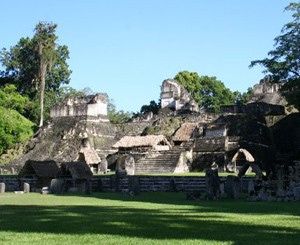
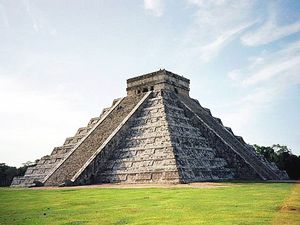
This is a name list of Maya gods and supernatural beings, mainly taken from the Books of Chilam Balam (CHB), Lacandon ethnography (LAC), Landa (L), and Popol Vuh (PV). Depending on the source, the name is Yucatec or K'iche'. The Classic Period names (belonging to a language related to modern Chol and Chorti) are only rarely known with certainty. Only those names have been listed which are familiar from popular books on the Maya, or which play an important role in scholarly discussions. Between square brackets, the correspondence with the deities in the revised Schellhas-Zimmermann-Taube list of codical deities has been indicated.
A
Acan The god of wine. His name means 'groan'. Acat Yucatec divine patron of those making scarifications and tattoos (Cogolludo); also called Acaat *CHB* and Ah Cat.[1] Ah Chuy Kak A god of war. Ah Ciliz A god of solar eclipses. Ah Mun *CHB* A designation of the Maya maize god. Ah Muzencab The gods of bees. Ah Pekku The god of thunder. Ah Pukuh The god of Deaths Ah Tabai The god of the hunt. Ah Uuc Ticab A god of the Earth. Ahau Chamahez A god of medicine and good health. Ajbit *PV* One of the thirteen creator gods who helped construct humanity from maize. Ajtzak *PV* One of the thirteen creator gods who helped construct humanity from maize. Akna Meaning "Our mother," a very general title applied, amongst others, to goddesses of fertility and childbirth. Alom *PV* A sky god and one of the creator deities who participated in the last two attempts at creating humanity. Awilix *PV* Patron of the Nija'ib' lineage of the K'iche'.
B
Bacab *L* [god N] Old god of the interior of the earth and of thunder, sky-carrier, fourfold. Balam Any of a group of jaguar gods who protected people and communities. Bitol *PV* A sky god and one of the creator deities who participated in the last two attempts at creating humanity. Bolon Ts'akab (Dzacab) *L* (god K) Ah Bolon Dzacab 'Innumerable Generations', the Lightning god, patron of the harvest and the seeds. Bolontiku *CHB* A group of nine underworld gods. Buluc Chabtan [god F] War god.
C
Cabrakan *PV* A god of mountains and earthquakes. He was a son of Vucub Caquix and Chimalmat. Cacoch *LAC* A creator god. Camazotz *PV* Bat god, tries to kill the Hero Twins Can Tzicnal *L* Bacab of the north, is assigned the color white, and the Muluc years, son of Itzamna and Ixchel. Chac *L* The god of Storms Chac Uayab Xoc *L* A fish god and the patron deity of fishermen. Chicchan A group of four Chorti rain gods who live in lakes and make rain clouds from the water in those lakes. Each of the rain gods was associated with a cardinal direction, similar to the Bacabs. Chiccan was also the name of a day in the Tzolkin cycle of the maya calendar. Cit-Bolon-Tum A god of medicine and healing. Chimalmat *PV* A giant who, by Vucub Caquix, was the mother of Cabrakan and Zipacna. Cizin A god of death who lived in Metnal. Colel Cab Mistress of the Bees Colop U Uichkin *RITUAL OF THE BACABS* An eclipse deity. Coyopa The god of thunder and brother of Cakulha. Cum Hau A god of death and the underworld.
E
Ekchuah Also spelled Ek Chuah, the "black war chief" was the patron god of warriors and merchants, depicted carrying a bag over his shoulder. In art, he was a dark-skinned man with circles around his eyes, a scorpion tail and dangling lower lip. In early modern studies of Maya art and iconography, he was sometimes referred to as God M before his identity was firmly established.
G
Gukumatz *PV* Feathered Snake god and creator. The depiction of the feathered serpent deity is present in other cultures of Mesoamerica. Gukumatz of the K'iche' Maya is closely related to the god Kukulkan of Yucatán and to Quetzalcoatl of the Aztec.
H
Hacha'kyum *LAC* Worshipped by the Lacandon people as their patron deity. Hobnil *L* Bacab of the east Hozanek *L* Bacab of the south; the ek element in the name may refer to a star or constellation. Hun Batz *PV* 'One Howler Monkey', one of the two stepbrothers of the Hero Twins, one of the Howler Monkey Gods and patron of the arts. Hun Came *PV* A demonic lord of the underworld (Xibalba) who, along with Vucub Caquix, killed Hun Hunahpu. They were killed in turn by the latter's sons, the Maya Hero Twins. Hun Chowen *PV* One of the two stepbrothers of the Hero Twins, one of the Howler Monkey Gods and patron of the arts. Hun Hunahpu *PV* The father of the Maya Hero Twins Ixbalanque and Hun-Apu by a virgin. Beheaded in Xibalba, the underworld, by the rulers of Xibalba, Hun Came and Vucub Caquix. His sons avenged his death. Hunab Ku 'Sole God', identical with Itzamna as the highest Yucatec god; or a more abstract upper god. Hunahpu *PV* One of the Maya Hero Twins. Hunahpu-Gutch *PV* One of the thirteen creator gods who helped create humanity. Hunahpu Utiu *PV* One of the thirteen creator gods who helped create humanity. Hun-nal-ye Hypothetical hieroglyphic reading of the name of the Classic Maya maize god Huraqan *PV* 'One-Leg', one of three lightning gods together called 'Heart of the Sky', and acting as world creators.
I
Itzamna The founder of the Maya culture, he taught his people to grow maize and cacao, as well as writing, calendars and medicine. Once mentioned as the father of the Bacabs. Connected to Kinich Ahau and Hunab Ku. Itzananohk'u A patron god of the Lacandon people. Ixbalanque > Xbalanque Ixchel *L* [goddess O] Jaguar goddess of midwifery and medicine. Ixmucane *PV* One of the thirteen creator gods who helped create humanity, grandmother of the Hero Twins. Ixpiyacoc *PV* One of the thirteen creator gods who helped create humanity. Ixtab *L* Goddess of suicide. Ixazaluoh A goddess of water and weaving.
J
K
Kauil (Kawil, K'awiil) Assumed to have been the Classic name of god K (Bolon Dzacab). Title attested for Itzamna, Uaxac Yol, and Amaite Ku; family name; probably not meaning 'food', but 'powerful'. Kinich Ahau *L* The solar deity. Kinich Kakmo A solar deity represented by a macaw, patron of Izamal (Yucatan). Kukulkán The plumed serpent. A Mayan aspect of the Mesoamerican traditional God Quetzalcoatl.
M
O
Oxlahuntiku *CHB* 'Thirteen Gods', possibly sky gods, opposed to Bolontiku. Mentioned in an eschatological passage.
Q
Qaholom *PV* one of the second set of creator gods. Q'uq'umatz *PV* Feathered Snake god and creator. The depiction of the feathered serpent deity is present in other cultures of Mesoamerica. Q'uq'umatz of the K'iche' Maya is closely related to the god Kukulkan of Yucatán and to Quetzalcoatl of the Aztecs.
T
Tepeu *PV* A sky god and one of the creator deities who participated in all three attempts at creating humanity. Tohil *PV* Tohil was a patron deity of the K'iche'. There was a great temple to him at their ancient capital of Q'umarkaj.
V
Votan legendary ancestral deity, Chiapas. Vucub-Caquix *PV* Bird demon, severs arm of Hero Twin, wife is Chimalmat, sons the demonic giants Cabrakan and Zipacna.
X
Xaman Ek god of travelers and merchants, who gave offerings to him on the side of roads while traveling. Xbalanque *PV* [god CH] War Twin, one of the Hero Twins, companion to Hunahpu Xmucane and Xpiayoc *PV* A creator god couple which helped create the first humans. They are also the parents of Hun Hunahpu and Vucub Hunahpu. They were called Grandmother of Day, Grandmother of Light and Bearer twice over, begetter twice over and given the titles midwife and matchmaker.
Y
Yaluk One of four Mopan 'Grandfathers' of the earth and chief lightning god. Yum Caax God of the woods, of wild nature, and of the hunt; invoked before carving out a maize field from the wilderness.
Z
Zac Cimi *L* Bacab of the west. Zipacna *PV* Demonic personification of the earth crust.
A
Acan The god of wine. His name means 'groan'. Acat Yucatec divine patron of those making scarifications and tattoos (Cogolludo); also called Acaat *CHB* and Ah Cat.[1] Ah Chuy Kak A god of war. Ah Ciliz A god of solar eclipses. Ah Mun *CHB* A designation of the Maya maize god. Ah Muzencab The gods of bees. Ah Pekku The god of thunder. Ah Pukuh The god of Deaths Ah Tabai The god of the hunt. Ah Uuc Ticab A god of the Earth. Ahau Chamahez A god of medicine and good health. Ajbit *PV* One of the thirteen creator gods who helped construct humanity from maize. Ajtzak *PV* One of the thirteen creator gods who helped construct humanity from maize. Akna Meaning "Our mother," a very general title applied, amongst others, to goddesses of fertility and childbirth. Alom *PV* A sky god and one of the creator deities who participated in the last two attempts at creating humanity. Awilix *PV* Patron of the Nija'ib' lineage of the K'iche'.
B
Bacab *L* [god N] Old god of the interior of the earth and of thunder, sky-carrier, fourfold. Balam Any of a group of jaguar gods who protected people and communities. Bitol *PV* A sky god and one of the creator deities who participated in the last two attempts at creating humanity. Bolon Ts'akab (Dzacab) *L* (god K) Ah Bolon Dzacab 'Innumerable Generations', the Lightning god, patron of the harvest and the seeds. Bolontiku *CHB* A group of nine underworld gods. Buluc Chabtan [god F] War god.
C
Cabrakan *PV* A god of mountains and earthquakes. He was a son of Vucub Caquix and Chimalmat. Cacoch *LAC* A creator god. Camazotz *PV* Bat god, tries to kill the Hero Twins Can Tzicnal *L* Bacab of the north, is assigned the color white, and the Muluc years, son of Itzamna and Ixchel. Chac *L* The god of Storms Chac Uayab Xoc *L* A fish god and the patron deity of fishermen. Chicchan A group of four Chorti rain gods who live in lakes and make rain clouds from the water in those lakes. Each of the rain gods was associated with a cardinal direction, similar to the Bacabs. Chiccan was also the name of a day in the Tzolkin cycle of the maya calendar. Cit-Bolon-Tum A god of medicine and healing. Chimalmat *PV* A giant who, by Vucub Caquix, was the mother of Cabrakan and Zipacna. Cizin A god of death who lived in Metnal. Colel Cab Mistress of the Bees Colop U Uichkin *RITUAL OF THE BACABS* An eclipse deity. Coyopa The god of thunder and brother of Cakulha. Cum Hau A god of death and the underworld.
E
Ekchuah Also spelled Ek Chuah, the "black war chief" was the patron god of warriors and merchants, depicted carrying a bag over his shoulder. In art, he was a dark-skinned man with circles around his eyes, a scorpion tail and dangling lower lip. In early modern studies of Maya art and iconography, he was sometimes referred to as God M before his identity was firmly established.
G
Gukumatz *PV* Feathered Snake god and creator. The depiction of the feathered serpent deity is present in other cultures of Mesoamerica. Gukumatz of the K'iche' Maya is closely related to the god Kukulkan of Yucatán and to Quetzalcoatl of the Aztec.
H
Hacha'kyum *LAC* Worshipped by the Lacandon people as their patron deity. Hobnil *L* Bacab of the east Hozanek *L* Bacab of the south; the ek element in the name may refer to a star or constellation. Hun Batz *PV* 'One Howler Monkey', one of the two stepbrothers of the Hero Twins, one of the Howler Monkey Gods and patron of the arts. Hun Came *PV* A demonic lord of the underworld (Xibalba) who, along with Vucub Caquix, killed Hun Hunahpu. They were killed in turn by the latter's sons, the Maya Hero Twins. Hun Chowen *PV* One of the two stepbrothers of the Hero Twins, one of the Howler Monkey Gods and patron of the arts. Hun Hunahpu *PV* The father of the Maya Hero Twins Ixbalanque and Hun-Apu by a virgin. Beheaded in Xibalba, the underworld, by the rulers of Xibalba, Hun Came and Vucub Caquix. His sons avenged his death. Hunab Ku 'Sole God', identical with Itzamna as the highest Yucatec god; or a more abstract upper god. Hunahpu *PV* One of the Maya Hero Twins. Hunahpu-Gutch *PV* One of the thirteen creator gods who helped create humanity. Hunahpu Utiu *PV* One of the thirteen creator gods who helped create humanity. Hun-nal-ye Hypothetical hieroglyphic reading of the name of the Classic Maya maize god Huraqan *PV* 'One-Leg', one of three lightning gods together called 'Heart of the Sky', and acting as world creators.
I
Itzamna The founder of the Maya culture, he taught his people to grow maize and cacao, as well as writing, calendars and medicine. Once mentioned as the father of the Bacabs. Connected to Kinich Ahau and Hunab Ku. Itzananohk'u A patron god of the Lacandon people. Ixbalanque > Xbalanque Ixchel *L* [goddess O] Jaguar goddess of midwifery and medicine. Ixmucane *PV* One of the thirteen creator gods who helped create humanity, grandmother of the Hero Twins. Ixpiyacoc *PV* One of the thirteen creator gods who helped create humanity. Ixtab *L* Goddess of suicide. Ixazaluoh A goddess of water and weaving.
J
K
Kauil (Kawil, K'awiil) Assumed to have been the Classic name of god K (Bolon Dzacab). Title attested for Itzamna, Uaxac Yol, and Amaite Ku; family name; probably not meaning 'food', but 'powerful'. Kinich Ahau *L* The solar deity. Kinich Kakmo A solar deity represented by a macaw, patron of Izamal (Yucatan). Kukulkán The plumed serpent. A Mayan aspect of the Mesoamerican traditional God Quetzalcoatl.
M
O
Oxlahuntiku *CHB* 'Thirteen Gods', possibly sky gods, opposed to Bolontiku. Mentioned in an eschatological passage.
Q
Qaholom *PV* one of the second set of creator gods. Q'uq'umatz *PV* Feathered Snake god and creator. The depiction of the feathered serpent deity is present in other cultures of Mesoamerica. Q'uq'umatz of the K'iche' Maya is closely related to the god Kukulkan of Yucatán and to Quetzalcoatl of the Aztecs.
T
Tepeu *PV* A sky god and one of the creator deities who participated in all three attempts at creating humanity. Tohil *PV* Tohil was a patron deity of the K'iche'. There was a great temple to him at their ancient capital of Q'umarkaj.
V
Votan legendary ancestral deity, Chiapas. Vucub-Caquix *PV* Bird demon, severs arm of Hero Twin, wife is Chimalmat, sons the demonic giants Cabrakan and Zipacna.
X
Xaman Ek god of travelers and merchants, who gave offerings to him on the side of roads while traveling. Xbalanque *PV* [god CH] War Twin, one of the Hero Twins, companion to Hunahpu Xmucane and Xpiayoc *PV* A creator god couple which helped create the first humans. They are also the parents of Hun Hunahpu and Vucub Hunahpu. They were called Grandmother of Day, Grandmother of Light and Bearer twice over, begetter twice over and given the titles midwife and matchmaker.
Y
Yaluk One of four Mopan 'Grandfathers' of the earth and chief lightning god. Yum Caax God of the woods, of wild nature, and of the hunt; invoked before carving out a maize field from the wilderness.
Z
Zac Cimi *L* Bacab of the west. Zipacna *PV* Demonic personification of the earth crust.
In Maya mythology, Ixbalanque or Xbalanque was originally a son of Hun Hunahpu and the virgin Blood Moon. His twin was Hunahpu. The two were the Maya Hero Twins and together their story forms a large part of the Popol Vuh, documenting the Mayan creation myth. Xbalanque and his brother Hunahpu were quite inseperable in their lives, together outwitting arrogant gods and the lords of the Mayan underworld, Xibalba. Although it is not explicitly stated in the Popol Vuh, Hunahpu seems to have been the dominant one among the brothers, often the one to do the talking and the planning, although Xbalanque was not merely a hapless sidekick. Xbalanque is credited with saving his older brother's life at least once. Xbalanque ascended to the heavens after his death and became associated with the full moon. Xbalanque is sometimes referred to as the Mayan moon goddess, having switched genders in those versions of the myth.
Hunahpu - Hun-Apu
In Maya mythology, Hun-Apu or Hunahpu was a son of Hun Hunahpu and Blood Moon, and an older twin to Xbalanque; the two were the Maya Hero Twins. The story of Hunahpu and his brother are told in the Popol Vuh. The pair were apparently well favored by the greater Mayan gods, and over their lifetimes had a long career of defeating their enemies through trickery and great powers.
Hunahpu and his brother were conceived in an unusual fashion, when their mother Blood Moon spoke with the decapitated head of their father Hun Hunahpu. The skull spat upon the maiden's hand, and it was this act that caused the twins to be conceived in her womb. Blood Moon sought out Hun Hunahpu's mother, who begrudgingly took her in after setting up a number of trials to prove her identity.
Even after birth, Hunahpu and Xbalanque were not well treated by their grandmother or their older half-brothers One Monkey and One Artisan. Immediately after their births, their grandmother demanded they be removed from the house due to their crying, and their elder brothers obliged by placing them in unusual places to sleep; on an anthill and among the brambles. Their intent was to kill their younger half-brothers out of jealousy and spite, for the older pair had long been revered as fine artisans and thinkers, and feared the newcomers would steal from the attention they received.
The attempts to kill the young twins after birth were a failure, and the boys grew up without any obvious spite for their ill-natured older siblings. During their younger years, the twins were made to labor, going to hunt birds which they brought back for meals. The elder brothers were given their food to eat first, in spite of the fact they spend the day singing and playing while the younger twins were working.
Hunahpu and Xbalanque demonstrated their wit at a young age in dealing with their older half brothers. One day the pair returned from the field without any birds to eat, and were questioned by their older siblings. The younger boys claimed that they had indeed shot several birds but that they had gotten caught high in a tree and were unable to retrieve them. The older brothers were brought to the tree and climbed up to get the birds, when the tree suddenly began to grow even taller, and the older brothers were caught. This is also the first instance in which the twins demonstrate supernatural powers, or perhaps simply the blessings of the greater gods; the feats of power are often only indirectly attributed to the pair.
Hunahpu further humiliated his older brethren by instructing them to remove their pants and tie them about their waists in an attempt to climb down. The pants became tails, and the brothers were transformed into monkeys. When their grandmother was informed that the older boys had not been harmed, she demanded they be allowed to return. When they did come back to the home, their grandmother was unable to contain her laughter at their appearance, and the disfigured brothers ran away in shame.
At a point in their lives not specified in the Popol Vuh, the twins were approached by the god Huracan regarding an arrogant god named Seven Macaw (Vucub Caquix). Seven Macaw had built up a following of worshipers among some of the inhabitants of the Earth, making false claims to be either the sun or the moon. Seven Macaw was also extremely vain, adorning himself with metal ornaments in his wings and a set of false teeth made of gemstones.In a first attempt to dispatch the vain god, the twins attempted to sneak upon him as he was eating his meal in a tree, and shot at his jaw with a blowgun. Seven Macaw was knocked from his tree but only wounded, and as Hunahpu attempted to escape, his arm was grabbed by the god and torn off.
In spite of their initial failure, the twins again demonstrated their clever nature in formulating a plan for Seven Macaw's defeat. Invoking a pair of gods disguised as grandparents, the twins instructed the invoked gods to approach Seven Macaw and negotiate for the return of Hunapuh's arm. In doing so, the "grandparents" indicated they were but a poor family, making a living as doctors and dentists and attempting to care for their orphaned grandchildren. Upon hearing this Seven Macaw requested that his teeth be fixed since they had been shot and knocked loose by the blowgun, and his eyes cured (it is not specifically said what ailed his eyes). In doing so the grandparents replaced his jeweled teeth with white corn, and plucked the ornaments he had about his eyes, leaving the god destitute of his former greatness. Having fallen, Seven Macaw died, presumably of shame.
Seven Macaw's sons, Zipacna and Cabrakan, inherited a large part of their father's arrogance, claiming to be the creators and destroyers of mountains, respectively. The elder son Zipacna was destroyed when the twins tricked him with the lure of a fake crab, burying him beneath a mountain in the process. More detail regarding Zipacna's deeds and his defeat can be found in the article about Zipacna.
The Mayan god Huracan again implored the young twins for help in dealing with Seven Macaw's younger son, Cabrakan, the Earthquake. Again it was primarily through their cleverness that the pair were able to bring about the downfall of their enemy, having sought him out and then using his very arrogance against him; they told the story of a great mountain they had encountered that kept growing and growing. Cabrakan prided himself as the one to bring down the mountains, and upon hearing such a tale, he predictably demanded to be shown the mountain. Hunahpu and Xbalanque obliged, leading Cabrakan toward the non-existent mountain. Being skilled hunters, they shot down several birds along the way, roasting them over fires and playing upon Cabrakan's hunger. When he asked for some meat, he was given a bird that had been prepared with plaster and gypsum, apparently a poison to the god. Upon eating it, he was weakened, and the boys were able to bind him and cast him into a hole in the earth, burying him forever.
Hunahpu and Xbalanque played ball in the same court that their father and his brother had played in long before them. When One Hunahpu and his brother had played, the noise had disturbed the Lords of Xibalba, rulers of the Mayan underworld. The Xibalbans summoned them to play ball in their own court. Doing so was a trap, however, as the Xibalbans used a bladed ball which was used to kill and decapitate the young men for disturbing their peace.When the twins began to play ball in the court, once again the Lords of Xibalba were disturbed by the racket, and sent summons to the boys to come to Xibalba and play in their court. Fearing they would suffer the same fate, their grandmother relayed the message only indirectly, telling it to a louse which was hidden in a toad's mouth, which was in turn hidden in the belly of a falcon. Nevertheless the boys did receive the message, and much to their grandmother's dismay, set off to Xibalba.
When their father had answered the summons, he and his brother were met with a number of challenges along the way which served to confuse and embarrass them before their arrival, but the younger twins would not fall victim to the same tricks. They sent a mosquito ahead of them to bite at the Lords and uncover which were real and which were simply mannequins, as well as uncovering their identities. When they arrived at Xibalba they were easily able to identify which were the real Lords of Xibalba and address them by name. They also turned down the Lords' invitation to sit upon a bench for visitors, correctly identifying the bench as a heated stone for cooking. Frustrated by the twins' ability to see through their traps, they sent the boys away to the Dark House, the first of several deadly tests devised by the Xibalbans.
Their father One Hunahpu and his brother had suffered embarrassing defeats in each of the tests, but again Hunahpu and Xbalanque demonstrated their prowess by outwitting the Xibalbans on the first of the tests, surviving the night in the pitch black house without using up their torch. Dismayed, the Xibalbans bypassed the remaining tests and invited the boys directly to the game. The twins knew that the Xibalbans used a special ball that had a blade with which to kill them, and instead of falling for the trick Hunahpu stopped the ball with a racket and spied the blades. Complaining that they had been summoned only to be killed, Hunahpu and Xbalanque threatened to leave the game.
As a compromise, the Lords of Xibalba allowed the boys to use their own rubber ball, and a long and proper game ensued. In the end the twins allowed the Xibalbans to win the game, but this was again a part of their ruse. They were sent to Razor House, the second deadly test of Xibalba, filled with knives that moved of their own accord. The twins however spoke to the knives and convinced them to stop, thereby ruining the test. They also sent leafcutting ants to retrieve petals from the gardens of Xibalba, a reward to be offered to the Lords for their victory. The Lords had intentionally chosen a reward they thought impossible, for the flowers were well guarded, but the guards did not take notice of the ants, and were killed for their inability to guard the flowers.
The twins played a rematch with the Xibalbans and lost by intent again, and were sent to Cold House, the next test. This test they defeated, as well. In turn, Hunahpu and Xbalanque by purpose lost their ball games so that they might be sent to the remaining tests, Jaguar House, Fire House, Bat House and in turn defeat the tests of the Xibalbans. The Lords of Xibalba were dismayed at the twins success, until the twins were placed in Bat House. Though they hid inside their blowguns from the deadly bats, Hunahpu peeked out to see if daylight had come, and was decapitated by a bat.The Xibalbans were overjoyed that Hunahpu had been defeated. Xbalanque summoned the beasts of the field, however, and fashioned a replacement head for Hunahpu. Though his original head was used as the ball for the next day's game, the twins were able to surreptitiously substitute a squash or a gourd for the ball, retrieving Hunahpu's real head and resulting in an embarrassing defeat for the Xibalbans.
Embarrassed by their defeat the Xibalbans still sought to destroy the twins. They had a great oven constructed and once again summoned the boys, intending to trick them into the oven and to their deaths. The twins realized that the Lords had intended this ruse to be the end of them, but nevertheless they allowed themselves to be burned in the oven, killed and ground into dust and bones. The Xibalbans were elated at the apparent demise of the twins, and cast their remnants into a river. This was, however, a part of the plan devised by the boys, and when cast into the river their bodies regenerated, first as a pair of catfish, and then as a pair of young boys again.Not recognizing them, the boys were allowed to remain among the
Xibalbans.
Tales of their transformation from catfish spread, as well as tales of their dances and the way they entertained the people of Xibalba. They performed a number of miracles, setting fire to homes and then bringing them back whole from the ashes, sacrificing one another and rising from the dead. When the Lords of Xibalba heard the tale, they summoned the pair to their court to entertain them, demanding to see such miracles in action.The boys answered the summons, and volunteered to entertain the Lords at no cost. Their identities remained secret for the moment, claiming to be orphans and vagabonds, and the Lords were none the wiser. They went through their gamut of miracles, slaying a dog and bringing it back from the dead, causing the Lords' house to burn around them while the inhabitants were unharmed, and then bringing the house back from the ashes. In a climactic performance, Xbalanque cut Hunahpu apart and offered him as a sacrifice, only to have the older brother rise once again from the dead.
Enthralled by the performance, One Death and Seven Death, the highest lords of Xibalba, demanded that the miracle be performed upon them. The twins obliged by killing and offering the lords as a sacrifice, but predictably did not bring them back from the dead. The twins then shocked the Xibalbans by revealing their identities as Hunahpu and Xbalanque, sons of One Hunahpu whom they had slain years ago along with their uncle Seven Hunahpu. The Xibalbans despaired, confessed to the crimes of killing the brothers years ago, and begged for mercy. As a punishment for their crimes, the realm of Xibalba was no longer to be a place of greatness, and the Xibalbans would no longer receive offerings from the people who walked on the Earth above. All of Xibalba had effectively been defeated.
With Xibalba defeated and the arrogant gods disposed of, Hunahpu and Xbalanque had one final act to accomplish. They returned to the Xibalban ball court and retrieved the buried remains of their father, One Hunahpu, and attempted to rebuild him. Although his body was made whole again he was not the same, and was unable to function as he once did. The twins left their father there in the ball court, but before doing so told him that he would be prayed to by those who sought hope, and this eased his heart.
Then finished, the pair departed Xibalba and climbed back up to the surface of the Earth. They did not stop there, however, and continued climbing straight on up into the sky. Hunahpu was immortalized as the Venus, the morning star, while Xbalanque became the full moon.
While not directly revered as gods themselves, Hunahpu and Xbalanque played an integral role in the Mayan creation story as being of superhuman stature, perhaps demigods or minor deities themselves, always favored by the greater gods. Although many of their acts and successes came about as a result of trickery and deceit, this was viewed more as cleverness than dishonesty, and their roles in defeating the vain and arrogant gods as well as the evil lords of the underworld Xibalba solidifies their characters as being that of good.
Ah Kinchil: the Sun god.
Ah Puch: the god of Death.
Ahau Chamahez: one of two gods of Medicine.
Ahmakiq: a god of Agriculture who locks up the wind when it threatens to destroy the crops.
Akhushtal: the goddess of Childbirth
Bacabs: the bacabs are the canopic gods, thought to be brothers, who, with upraised arms, supported the multilayered sky from their assigned positions at the four cardinal points of the compass. (The Bacabs may also have been four manifestations of a single deity.) The four brothers were probably the offspring of Itzamn•, the supreme deity, and Ixchel, the goddess of weaving, medicine, and childbirth. Each Bacab presided over one year of the four-year cycle. The Maya expected the Muluc years to be the greatest years, because the god presiding over these years was the greatest of the Bacab gods. The four directions and their corresponding colours (east, red; north, white; west, black; south, yellow) played an important part in the Mayan religious and calendrical systems.
Mayan god of rain, especially important in the Yucatan region of Mexico where he was depicted in Classic times with protruding fangs, large round eyes, and a proboscis-like nose. In post-Classic Mayan and Toltec ruins, reclining figures known as the Chacs Mool are thought to represent the rain god. Following the Spanish conquest, the Chacs were associated with Christian saints and were often depicted on horseback.
Cit Bolon Tum: a god of Medicine.
Cizin (Kisin): "Stinking One"; Mayan earthquake god and god of death, ruler of the subterranean land of the dead. He lives beneath the earth in a purgatory where all souls except those of soldiers killed in battle and women who died in childbirth spend some time. Suicides are doomed to his realm for eternity. He may possibly have been one aspect of a malevolent underworld deity who manifested himself under several names and guises (e.g., Ah Puch, Xibalba, and Yum Cimil). In pre-Conquest codices, or manuscripts, the god of death is frequently depicted with the god of war in scenes of human sacrifice. One aspect of the dualistic nature of the Mayan religion is symbolically portrayed in the existing codices, which show Cizin uprooting or destroying trees planted by Chac, the rain god. Cizin is often depicted on pottery and illustrated in the codices in the form of a dancing skeleton, holding a smoking cigarette. He is also known by his death collar, the most prominent feature of which consists of disembodied eyes dangling by their nerve cords. After the Spanish Conquest, Cizin became merged with the Christian devil.
Ekahau: the god of Travellers and Merchants.
Itzamn: "Iguana House" - Principal pre-Columbian Mayan deity. The ruler of heaven, day, and night, he frequently appeared as four gods called Itzamn•s, who encased the world. Like some of the other Mesoamerican deities, the Itzamn•s were associated with the points of the compass and their colours (east, red; north, white; west, black; and south, yellow). Itzamn• was sometimes identified with the remote creator deity Hunab Ku and occasionally with Kinich Ahau, the sun-god. The moon goddess Ixchel, patroness of womanly crafts, was possibly a female manifestation of the god. Itzamn• was also a culture hero who gave humankind writing and the calendar and was patron deity of medicine.
Ixtab: the goddess of the Hanged. She receives their souls into paradise.
Kan-u-Uayeyab: the god who guarded cities.
Kinich Kakmo: the Sun god symbolised by the Macaw.
Kisin: see Cizin
Mitnal: Mitnal was the underworld hell where the wicked were tortured.
Nacon: Nacon was the god of War.
Tzultacaj (Tzuultaq'ah): For the Mayan Indians of central Guatemala, known as Kekchl, this was the god of the mountains and valleys.
Yaxche: Yaxche is the Tree of Heaven under which good souls rejoice
Mayan Gods and Goddesses
The ancient Maya had a complex pantheon of deities whom they worshipped and offered human sacrifices. Rulers were believed to be descendants of the gods and their blood was the ideal sacrifice, either through personal bloodletting or the sacrifice of captives of royal blood. The Mayan vision of the universe is divided into multiple levels, above and below earth, positioned within the four directions of north, south, east and west. After death, the soul was believed to go to the Underworld, Xibalba (shee bal bah), a place of fright where sinister gods tested and tricked their unfortunate visitors.
As with all Myths about Gods and Goddesses - Mayan creational mythology discuss connections with being from other realms who came to Earth to seed the planet. Many people connect the story of the Popol Vuh with a story of extraterrestrial Gods who came to earth and made man in their own image. When they first created man, he was perfect, living as long as the gods and having all of their abilities. Fearing their 'creation', the gods destroyed them. In the next evolution, a lower form of entity was created, 'human', as he exists today. Within Mayan culture they have legends of visiting Gods from outer space. As in all creational myths, religions, and prophecies, the gods promise to return one day.
________________________________________
Kukulcan - Winged God - Feather Serpent
The ancient Maya had a complex pantheon of deities whom they worshipped and offered human sacrifices. Rulers were believed to be descendants of the gods and their blood was the ideal sacrifice, either through personal bloodletting or the sacrifice of captives of royal blood. The Mayan vision of the universe is divided into multiple levels, above and below earth, positioned within the four directions of north, south, east and west. After death, the soul was believed to go to the Underworld, Xibalba (shee bal bah), a place of fright where sinister gods tested and tricked their unfortunate visitors.
As with all Myths about Gods and Goddesses - Mayan creational mythology discuss connections with being from other realms who came to Earth to seed the planet. Many people connect the story of the Popol Vuh with a story of extraterrestrial Gods who came to earth and made man in their own image. When they first created man, he was perfect, living as long as the gods and having all of their abilities. Fearing their 'creation', the gods destroyed them. In the next evolution, a lower form of entity was created, 'human', as he exists today. Within Mayan culture they have legends of visiting Gods from outer space. As in all creational myths, religions, and prophecies, the gods promise to return one day.
________________________________________
Kukulcan - Winged God - Feather Serpent

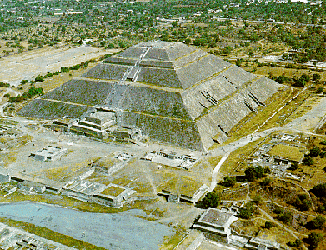
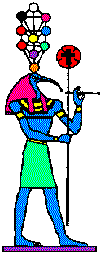
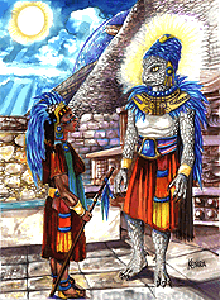
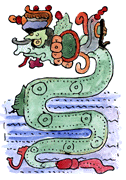
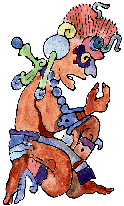
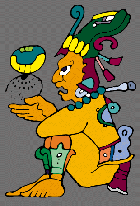

Double click here to edit this text.
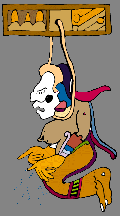
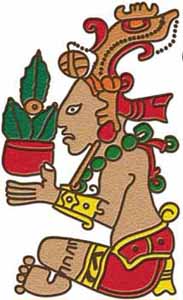
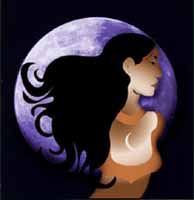
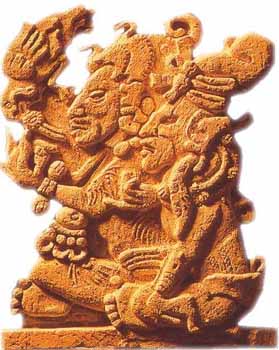
Mayan Pyramids
Sun, 6th November, 2011
The Mystery of the Mayan Pyramids
Please Sign Guestbook
Deep within the jungles of Mexico and Guatemala and extending into the limestone shelf of the Yucatan peninsula lie the mysterious temples and Mayan pyramids.
While Europe was still in the midst of the Dark Ages, these amazing people had mapped the heavens, evolved the only true writing system native to the Americas and were masters of mathematics.
They invented the calendars we use today. Without metal tools, beasts of burden or even the wheel they were able to construct vast cities across a huge jungle landscape with an amazing degree of architectural perfection and variety. Their legacy in stone, which has survived in a spectacular fashion at places such as Palenque, Tikal, Tulum, Chichen Itza, Copan and Uxmal, lives on as do the seven million descendants of the classic Maya civilization.
The Maya are probably the best-known of the classical civilizations of Mesoamerica. Originating in the Yucatan around 2600 B.C., they rose to prominence around A.D. 250 in present-day southern Mexico, Guatemala, northern Belize and western Honduras. Building on the inherited inventions and ideas of earlier civilizations such as the Olmec, the Maya developed astronomy, calendrical systems and hieroglyphic writing.
The Maya were noted as well for elaborate and highly decorated ceremonial architecture, including temple-pyramids, palaces and observatories, all built without metal tools. They were also skilled farmers, clearing large sections of tropical rain forest and, where groundwater was scarce, building sizable underground reservoirs for the storage of rainwater. The Maya were equally skilled as weavers and potters, and cleared routes through jungles and swamps to foster extensive trade networks with distant peoples.
The Mayan pyramids of Teotihuacan rise as high as twenty-story buildings,above the central Mexican highlands with a grandeur and mystery that stirs the imagination and inspires the soul. As a civil engineer, I have often been intrigued by the surveying and construction skills of so-called primitive societies; this site is truly exceptional. All of the buildings are aligned with the stars and the solar system from precise survey points in the nearby mountain range, using an advanced understanding of mathematics, geometry and astronomy.
Little is known by traditional researchers about the pyramids of Teotihuacan (pronounced tay-oh-tee-wah-con, and simply referred to as "Teo" by the locals). Built bythe Toltecs, Teo was once a city the size of ancient Athens and Rome. It thrived as the primary center of learning and culture in America for over one thousand years, before it was abandoned about fifteen-hundred years ago.
According to legend, after the fall of Teotihuacan, two major paths of sacred knowledge formed. One Toltec path went to Tula near present day Hidalgo. The magic of Tula can be compared to what our culture might term "black magic." The generally more enlightened path called the Path of Freedom went south toward Xochicalco, near present day Cuernavaca, and also eventually went into hiding.
The term "Toltec" as used by the Aztecs (who came many years after the Toltecs) meant either a "great wise one" or a native healer or artist who followed a certain tradition; it was not necessarily meant to define a specific ethnic group. In fact there is evidence that Toltec society was a relatively harmonious blend of several of America's early native cultures.
The Olmecs and the builders of Monte Alban in Oaxaca, with whom the Toltecs traded, revered the Toltecs and regarded them as the most highly advanced society in religion, magic and art. Yet, unlike the art of other early American societies, Toltec art depicts only two gods: the earth goddess and the rain/sky god. The fact that Toltec art does not prominently portray many gods for worship, supports the belief, common throughout America for over one thousand years, that the Toltecs were able to communicate directly with the gods in the sun, the moon and the stars.
While Europe was still in the midst of the Dark Ages, these amazing people had mapped the heavens, evolved the only true writing system native to the Americas and were masters of mathematics.
They invented the calendars we use today. Without metal tools, beasts of burden or even the wheel they were able to construct vast cities across a huge jungle landscape with an amazing degree of architectural perfection and variety. Their legacy in stone, which has survived in a spectacular fashion at places such as Palenque, Tikal, Tulum, Chichen Itza, Copan and Uxmal, lives on as do the seven million descendants of the classic Maya civilization.
The Maya are probably the best-known of the classical civilizations of Mesoamerica. Originating in the Yucatan around 2600 B.C., they rose to prominence around A.D. 250 in present-day southern Mexico, Guatemala, northern Belize and western Honduras. Building on the inherited inventions and ideas of earlier civilizations such as the Olmec, the Maya developed astronomy, calendrical systems and hieroglyphic writing.
The Maya were noted as well for elaborate and highly decorated ceremonial architecture, including temple-pyramids, palaces and observatories, all built without metal tools. They were also skilled farmers, clearing large sections of tropical rain forest and, where groundwater was scarce, building sizable underground reservoirs for the storage of rainwater. The Maya were equally skilled as weavers and potters, and cleared routes through jungles and swamps to foster extensive trade networks with distant peoples.
The Mayan pyramids of Teotihuacan rise as high as twenty-story buildings,above the central Mexican highlands with a grandeur and mystery that stirs the imagination and inspires the soul. As a civil engineer, I have often been intrigued by the surveying and construction skills of so-called primitive societies; this site is truly exceptional. All of the buildings are aligned with the stars and the solar system from precise survey points in the nearby mountain range, using an advanced understanding of mathematics, geometry and astronomy.
Little is known by traditional researchers about the pyramids of Teotihuacan (pronounced tay-oh-tee-wah-con, and simply referred to as "Teo" by the locals). Built bythe Toltecs, Teo was once a city the size of ancient Athens and Rome. It thrived as the primary center of learning and culture in America for over one thousand years, before it was abandoned about fifteen-hundred years ago.
According to legend, after the fall of Teotihuacan, two major paths of sacred knowledge formed. One Toltec path went to Tula near present day Hidalgo. The magic of Tula can be compared to what our culture might term "black magic." The generally more enlightened path called the Path of Freedom went south toward Xochicalco, near present day Cuernavaca, and also eventually went into hiding.
The term "Toltec" as used by the Aztecs (who came many years after the Toltecs) meant either a "great wise one" or a native healer or artist who followed a certain tradition; it was not necessarily meant to define a specific ethnic group. In fact there is evidence that Toltec society was a relatively harmonious blend of several of America's early native cultures.
The Olmecs and the builders of Monte Alban in Oaxaca, with whom the Toltecs traded, revered the Toltecs and regarded them as the most highly advanced society in religion, magic and art. Yet, unlike the art of other early American societies, Toltec art depicts only two gods: the earth goddess and the rain/sky god. The fact that Toltec art does not prominently portray many gods for worship, supports the belief, common throughout America for over one thousand years, that the Toltecs were able to communicate directly with the gods in the sun, the moon and the stars.
Facts About Mayan Pyramids
Mayan pryamids are steeped in rituals and mythology.
Mayan pyramids were built by the Mayan people who lived in southern Mexico, Guatemala, Honduras, El Salvador and Belize. The pyramids, which were built starting nearly 3,000 years ago, are perhaps the greatest tourist attractions of Mexico and Central America. Two types of pyramids were constructed: one for sacrificial rituals and the second for sacred ceremonies. Many Mayan pyramids also rose above the jungle to serve as landmarks for the populace.
Geography
Mayan pryamids are steeped in rituals and mythology.
Mayan pyramids were built by the Mayan people who lived in southern Mexico, Guatemala, Honduras, El Salvador and Belize. The pyramids, which were built starting nearly 3,000 years ago, are perhaps the greatest tourist attractions of Mexico and Central America. Two types of pyramids were constructed: one for sacrificial rituals and the second for sacred ceremonies. Many Mayan pyramids also rose above the jungle to serve as landmarks for the populace.
Geography
The Teotihuacan civilization created the most magnificent pyramids of Mesoamerica from about 300 B.C. to 500 A.D. Sites of pyramids throughout the region also include Altun Ha, Calakmul Caracol, Comalcalco, Coba, Chichen Itza, El Mirador, La Danta, El Tigre, Los Monos, Lamanai, Palenque, Tikal, Tulum and Uxmal.
Complex Architecture

Ceremonial Building
Ceremonial buildings began to appear in about 100 B.C., with the 650-square-foot Pyramid of the Sun standing 210 feet high and made of adobe mud and stone. Its temple constructed of wood at the summit of the edifice. The summit offered a stunning view of the city of Teotihuacan below.
Ceremonial buildings began to appear in about 100 B.C., with the 650-square-foot Pyramid of the Sun standing 210 feet high and made of adobe mud and stone. Its temple constructed of wood at the summit of the edifice. The summit offered a stunning view of the city of Teotihuacan below.
Decorative Element
His pyramid was the Pyramid of the Sun in Teotihuacan
Kukulcan was identified to Atlantis [Tehuti] -- Egypt [Thoth] -- Sumer [Ea or Enki] -- then later to Mesoamerica and Peru as Quetzalcoatl.
Quetzalcoatl ("feathered snake") is the Aztec name for the Feathered-Serpent deity of ancient Mesoamerica, one of the main gods of many Mexican and northern Central American civilizations.
The name "Quetzalcoatl" literally means quetzal-bird snake or serpent with feathers of the Quetzal (which implies something divine or precious) in the Nahuatl language. The meaning of his local name in other Mesoamerican languages is similar.
The Maya knew him as Kukulkna; the Quiche as Gukumatz. The Feathered Serpent deity was important in art and religion in most of Mesoamerica for close to 2,000 years, from the Pre-Classic era until the Spanish Conquest.
Gukumatz was a culture hero who taught the Toltecs, and later the Maya, the arts of civilization, including codes of law, agriculture, fishing and medicine. He came from an ocean, and eventually returned to it. According to Mayan legend, Gukumatz will return to the Earth during the End Times. He also represents the forces of good and evil, similar to the ying-yang paradigm of Oriental religions.
Gukumatz was a god of the four elements of fire, earth, air and water, and each element was associated with a divine animal or plant:
• Air -- Vulture
• Earth -- Maize
• Fire -- Lizard
• Water -- Fish
The worship of Quetzalcoatl sometimes included human sacrifices, although in other traditions Quetzalcoatl was said to oppose human sacrifice.
Mesoamerican priests and kings would sometimes take the name of a deity they were associated with, so Quetzalcoatl and Kukulcan are also the names of historical persons.
In the 10th century a ruler closely associated with Quetzalcoatl ruled the Toltecs; his name was Topiltzin Ce Acatl Quetzalcoatl. This ruler was said to be the son of either the great Chichimeca warror, Mixcoatl and the Colhuacano woman Chimalman, or of their descendant.
The Toltecs had a dualistic belief system. Quetzalcoatl's opposite was Tezcatlipoca, who supposedly sent Quetzalcoatl into exile. Alternatively, he left willingly on a raft of snakes, promising to return. When the Aztecs adopted the culture of the Toltecs, they made twin gods of Tezcatlipoca and Quetalcoat, opposite and equal; Quetalcoatl was also called White Tezcatlipoca, to contrast him to the black Tezcatlipoca. Together, they created the world; Tezcatlipoca lost his foot in that process.
The Aztec Emperor Moctezuma II initially believed the landing of Cortez in 1519 was Quetzalcoatl's return. Cortes played off this belief to aid in his conquest of Mexico. The exact significance and attributes of Quetzalcoatl varied somewhat between civilizations and through history. Quetzalcoatl was often considered the god of the morning star and his twin brother, Xolotl was the evening star (Venus). As the morning star he was known under the title Tlahuizcalpantecuhtli, which means literaly "the lord of the star of the dawn". He was known as the inventor of books and the calendar, the giver of maize corn to mankind, and sometime as a symbol of death and resurrection. Quetzalcoatl was also the patron of the priests and the title of the Aztec high priest.
Most Mesoamerican beliefs included cycles of worlds. Usually, our current time was considered the fifth world, the previous four having been destroyed by flood, fire and the like. Quetzalcoatl allegedly went to Mictlan, the underworld, and created fifth world-mankind from the bones of the previous races (with the help of Cihuacoatl), using his own blood to imbue the bones with new life.
His birth, along with his twin Xolotl, was unusual; it was a virgin birth, born to the goddess Coatlicue. Alternatively, he was a son of Xochiquetzal and Mixcoatl.
One Aztec story claims Quetzalcoatl was seduced by Tezcatlipoca but then burned himself to death out of remorse. His heart became the morning star.
Quetzalcoatl was a god of such importance and power that nearly no aspect of everyday life seemed to go untouched by him. Secondly, as a historical figure, his actions would nor could not be contained by the History and thus eventually evolved into myth. As a legend, he would signal the end of mortal kingship. An interesting phenomena that distinguished Quetzalcoatl is that despite the fact he is not the most powerful of gods within the Mesoamerican pantheon, or one of the eldest, he is nonetheless an integral part of the system. This was partially accomplished by his ability to integrate himself so securely to attributes of his fellow brethren, to such an extent that it is virtually impossible to tell if Quetzalcoatl was the true originator or vise versa. Hence, to establish a single definitive personality to a god is extremely difficult.
________________________________________
Other Mayan Gods and Goddesses
Chac
In Maya mythology, Chac (sometimes spelled "Chaac") was the god of rain and thunder, and important as a fertility and agriculture god. Like some other Maya gods, Chac was sometimes thought of as one god, and other times as 4 separate gods based in the four cardinal directions: "Chac Xib Chac", Red Chac of the East; "Sac Xib Chac", White North Chac; "Ek Xib Chac" Black West Chac", and "Kan Xib Chac", Yellow East Chac.
In art, he was sometimes depicted as an old man with some reptilian or amphibian features, with fangs and a long nose, sometimes tears coming from his eyes (symbolizing rain) and carrying an axe (which caused thunder). He was associated with the frog. Other Maya terms used to refer to Chac include Ah Tzenul, ("he who gives food away to other people"), Hopop Caan ("he who lights the sky"), and Ah Hoya ("he who urinates").Names for the Rain God in other Mesoamerican cultures include Cocijo (Zapotec) and Tlaloc (Aztec).
While most of the ancient Mesoamerican gods are long forgotten by the descendants of the original inhabitants today, prayers to the Chaacs, most generally as a routine and not in times of drought, are documented in Yucatán as continuing into the 21st century among nominal Christian Maya farmers. Anthropologists have documented other prayers still in use which are identical to pre-Columbian prayers to Chac except that the name Chac has been replaced by that of Saint Thomas.Chac should not be confused with the Maya-Toltec figure Chac Mool.
________________________________________
Another Sun God - Kinich Ahau or Ahaw Kin
Kinich Ahau was the Sun god. He was the patron god of the city Itzamal. Supposedly, he visited the city at noon everday. He would descend as a macaw and consume prepared offerings. Kinich Ahau is usually shown with jaguar-like features (ex. filed teeth). Kinich Ahau also wears the symbol of Kin, a Mayan day. Kinich Ahau was also know by the name Ah Xoc Kin, who was associated with poetry and music.
________________________________________
Yumil Kaxob
The Maize god is representative of the ripe grain which was the base of the Mayan agriculture. In certain areas of Mesoamerica, like Yucatan, the Maize god is combined with the god of flora, Yumil Kaxob. The Maize god is principally shown with a headdress of maize and a curved streak on his cheek. He is also noticeable from other gods throug his youth. Despite this youth, the Maize god was powerless by himself. His fortunes and misfortunes were decided by the control of rain and drought. The Rain god would protect him. However, he suffered when the Death god exercised drought and famine.
________________________________________
Yum Cimil
The death god was called Yum Cimil. He also could be called Ah Puch, the god of the Underworld. His body is predominantly skeletal. His adornments are likewise made of bones. Yum Cimil has also been represented with a body covered with black spots (decomposition). He also wears a collar with eyeless sockets. This adornment was the typical symbol for the Underworld.
________________________________________
Ixtab
________________________________________
Ixtab
The suicide goddess was called Ixtab. She is always represented with a rope around her neck. The Mayans believed that suicides would lead you to heaven. Hence, it was very common for suicides to happen because of depression or even for something trivial.
________________________________________
Yum Kaax
________________________________________
Yum Kaax
In Maya mythology, Yum Caax ("lord of the woods") was the personification of maize and a god of agriculture and nature.Alternative names: Yum Kaax, God E.Perhaps having origins in ancient northern hunting tradition, Yum Ka'ax, also called U Kanin Ka'ax, is known to indigenous peoples of North America. The one invoked by hunters, he is owner of all the game. He can appear to hunters in an instant, and possesses songs that will allow a hunter success or allow his arrows to come back to him.
________________________________________
Ix Chel
________________________________________
Ix Chel
Ix Chel, the Lady Rainbow - in Maya mythology, Ixchel or Ix Chel was an earth and moon goddess, patroness of weavers and pregnant women.One myth states that the sun was her "lover," but that her grandfather was very upset with this and he threw lightining at her out of jealousy which in turn killed Ix Chel.
In the story it stated that dragonflies sang over her for 183 days and then she awoke again only to follow the sun to his palace. But the sun soon after too started to become jealous of Ix Chel, thinking that she was having an affair with the morning star, who was the sun's brother. The sun threw her out of heaven and then persuaded her back home, but soon after her return he became jealous again. It is said that Ix Chel became annoyed with the bahavior of the sun and so she went off into the night and remained invisible whenever the sun came around. At her new place in the night it is said that Ix Chel spent the nights nursing women of Earth through their labor (during the stint of their pregnancy and birth).
The story of Ix Chel and Itzamna shows both interesting similarities and differences with the Japanese myth of Izanagi and Izanami. The names and personalities are reversed in one version of the story as compared to the other. Izanami is the female, and she is the one who violently attacks her husband. Ix Chel was said to pay special attention to the pilgrims who visited Cozumel, which was her sacred island. Isla Mujeres was also devoted to her worship.
________________________________________
Ixbalanque
In the story it stated that dragonflies sang over her for 183 days and then she awoke again only to follow the sun to his palace. But the sun soon after too started to become jealous of Ix Chel, thinking that she was having an affair with the morning star, who was the sun's brother. The sun threw her out of heaven and then persuaded her back home, but soon after her return he became jealous again. It is said that Ix Chel became annoyed with the bahavior of the sun and so she went off into the night and remained invisible whenever the sun came around. At her new place in the night it is said that Ix Chel spent the nights nursing women of Earth through their labor (during the stint of their pregnancy and birth).
The story of Ix Chel and Itzamna shows both interesting similarities and differences with the Japanese myth of Izanagi and Izanami. The names and personalities are reversed in one version of the story as compared to the other. Izanami is the female, and she is the one who violently attacks her husband. Ix Chel was said to pay special attention to the pilgrims who visited Cozumel, which was her sacred island. Isla Mujeres was also devoted to her worship.
________________________________________
Ixbalanque
Cholula was the Holy Place of the three major satellite cities of Teotihuacan. It was destroyed by Cortes and his men on their way to take Tenochtitlan. The pyramid is in the present day city of Cholula and in volume (before destruction) was larger than the Egyptian pyramid of Cheops. After conquest a church was built on top of the ruins.
Elevation; 7,000 feet
Three successively larger Mayan pyramids were built on top of each other here, and served important ceremonial purposes for the Aztecs. The last and largest pyramid was faced with stucco, which if not maintained turns back to mud. When the pyramid was abandoned, the stucco turned back to mud, and plants and eventually trees grew on it.
Historians think the Spaniards were not aware that they were building their church on top of an Aztec pyramid - perhaps they just built there because it was the highest hill in the area! However, it is very common, both in Mexico and in other cultures where belief systems have warred, to see buildings associated with one culture constructed on top of or from the rubble of buildings associated with the other culture.
In Izamal, for example, a large cathedral and courtyard are build on top of a lopped-off pyramid. In India, too, one can see mosques constucted from stones whose carvings show that they were originally part of Hindu temples.
--------------------------------------------------------------------------------
Tzintzuntzan, Mexico - Hummingbirds in Stone
The great platform, measuring 425 by 250 meters would hold thirty soccer fields.
Elevation; 7,000 feet. Site of the longest pyramid in the West (3,100 feet).
The name is said to mean "place abundant in hummingbirds", or if properly pronounced to sound like a hummingbird beating its wings
Elevation; 7,000 feet
Three successively larger Mayan pyramids were built on top of each other here, and served important ceremonial purposes for the Aztecs. The last and largest pyramid was faced with stucco, which if not maintained turns back to mud. When the pyramid was abandoned, the stucco turned back to mud, and plants and eventually trees grew on it.
Historians think the Spaniards were not aware that they were building their church on top of an Aztec pyramid - perhaps they just built there because it was the highest hill in the area! However, it is very common, both in Mexico and in other cultures where belief systems have warred, to see buildings associated with one culture constructed on top of or from the rubble of buildings associated with the other culture.
In Izamal, for example, a large cathedral and courtyard are build on top of a lopped-off pyramid. In India, too, one can see mosques constucted from stones whose carvings show that they were originally part of Hindu temples.
--------------------------------------------------------------------------------
Tzintzuntzan, Mexico - Hummingbirds in Stone
The great platform, measuring 425 by 250 meters would hold thirty soccer fields.
Elevation; 7,000 feet. Site of the longest pyramid in the West (3,100 feet).
The name is said to mean "place abundant in hummingbirds", or if properly pronounced to sound like a hummingbird beating its wings
Mayan pyramid of the Magician at Uxma
--------------------------------------------------------------------------------
--------------------------------------------------------------------------------
Palace of the Governors at Uxmal
